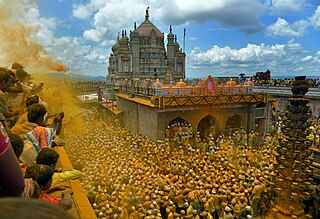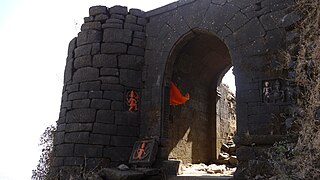Related Research Articles
The Maratha caste is composed of 96 clans, originally formed in the earlier centuries from the amalgamation of families from the peasant (Kunbi), shepherd (Dhangar), blacksmith (Lohar), pastoral (Gavli), carpenter (Sutar), Bhandari, Thakar and Koli castes in Maharashtra. Many of them took to military service in the 16th century for the Deccan sultanates or the Mughals. Later in the 17th and 18th centuries, they served in the armies of the Maratha Kingdom, founded by Shivaji, a Maratha Kunbi by caste. Many Marathas were granted hereditary fiefs by the Sultanates, and Mughals for their service.

The Peshwa was the second highest office in the Maratha Confederacy, next in rank and prestige only to that of the Chhatrapati. Initially serving as the appointed prime minister in the Maratha Kingdom, the office became hereditary after the death of Shahu in 1749. During the reign of Shahu, the office of Peshwa grew in power and the Peshwas came to be the de facto rulers of the Maratha Confederacy. However following the defeat of the Marathas in 1761, the office of the Peshwa became titular as well and from that point onwards served as the ceremonial head of the Confederacy underneath the Chhatrapati.

Pune district is a district in Western Maharashtra with Administrative Headquarters in Pune city. Pune district is the most populous district in the Indian state of Maharashtra. It is one of the most industrialised districts in India.
Vasudev Balwant Phadke was an Indian independence activist and revolutionary who sought India's independence from colonial rule. Phadke was moved by the plight of the farming community and believed that Swaraj was the only remedy for their ills. With the help of various sub-communities of Hindu society he created a movement against British rule. The group started an armed struggle to overthrow the colonial government, launching raids on wealthy European businessmen to obtain funds for the purpose. Phadke came to prominence when he got control of the city of Pune for a few days after catching colonial soldiers off-guard during a surprise attack.
The Nayak, or Naik is a historic honorific title conferred on military captains and governors of feudal states in the Middle Ages. Today it is also a surname. Nayaks are mostly Hindu and few Sikhs, who follow Hinduism and Sikhism respectively.

Jejuri is a city and a municipal council in the Pune district of Maharashtra, India. Khandoba Mandir is an important Hindu temple to the Hindu Lord Khandoba, one of the most visited tirtha in Maharashtra.
In May and June 1875,peasants of Maharashtra in some parts of Poona and Ahmednagar districts revolted against increasing agrarian distress. The Deccan Riots of 1875 targeted conditions of debt peonage (kamiuti) to moneylenders. The rioters' specific purpose was to obtain and destroy the bonds, decrees, and other documents in the possession of the moneylenders. The peasants began a systematic attack on the moneylenders’ houses and shops. They seized and publicly burnt debt bonds and deeds signed under pressure, in ignorance, or through fraud and other documents dealing with their debts. They socially boycotted the moneylenders. Within days the disturbances spread to other villages of the Poona and Ahmednagar districts, although there was no anti-colonial consciousness among them.
Pune is the 9th most populous city in India and one of the largest in the state of Maharashtra.

Purandar Fort is a mountain fort in Pune district in Western Indian state of Maharashtra, India. The fort stands at 1,374 metres (4,508 ft) above the sea level in the Western Ghats, 50 kilometres (31 mi) to the southeast of Pune.

The Koli is an Indian caste that is predominantly found in India, but also in Pakistan and Nepal. Koli is an agriculturist caste of Gujarat but in coastal areas they also work as fishermen along with agriculture.
The Patil is a title used by Koli chiefs of villages in Maharashtra.
Krishna Sable Sabla was an Indian freedom fighter. He was born in Sabla village in present-day Maharashtra. Along with Tantya Makaji, he led a rebellion against the British.
The Javjirao Hirajirao Bamble also known as Jivaji Bamble was a Koli Mansabdar of Rajur in the Maratha Empire, was the Deshmukh of 60 villages and chief of the Bamble clan. His family had been Vassals since the time of the Bahmani Sultanate. After the death of his father Hiraji Bamble, he succeeded his father.
Khemirao Sarnaik was a Koli Deshmukh of the Maval region in 1640s, rebelled against Mughal governor Aurangzeb and abolished Jizya.

Naik Govind Rao Khare was the Subedar of the hill fort Ratangarh under Peshwa government in the Maratha Empire. He was born in a farming family of Maharashtra. Khare was a revolutionary of the Indian independence movement who took up arms against the British rule in Maharashtra and declared the end of British rule. he was chief of the Kolis of Khare (Khade) clan and belong to the Mahadev koli family and led the rebellion from 1819 to 1830. his family was chief of the four villages and was tributary to peshwa and enjoying the Deshmukhi.

Bapuji Bhangare was a Koli Patil of Deogaon and Indian freedom fighter who challenged the British government in Maharashtra state of British India. Bapuji Bhangare breakdown the British government strongly in Pune, Ahmadnagar and Nashik districts of Maharashtra.
The Ramji Bhangare, or Ramji Bhangria was a revolutionary from Maharashtra, Patil of Devgaon, Jemadar in British Indian Army and was father of the revolutionaries Raghoji Bhangare and Bapuji Bhangare. He challenged and breakdown the British authorities in Konkan from 1798 to 1814. but before this, during the reign of Bajirao Peshwa, he along with his uncle Valoji Bhangare, revolted against Peshwa government because of land rights of locals and plundered the several territorial places of Peshwa.
The Chimaji Jadhav was Indian freedom fighter from Maharashtra in India and he led the rebellion from 1839 to 1846. He revolted against British government along with his supporters Nana Darbare and Bhau Khare to re-established the deposed Peshwa on the Maratha throne.
Hari Makaji Naik was an Indian freedom activist from Koli caste of Maharashtra who challenged the British rule in India. He was Koli by caste but led the Ramoshis of Satara, attacking British offices, revenue centers and officials in the Pune, Satara and Solapur districts of Bombay Presidency.
References
- 1 2 3 Robinson, Frederick Bruce (1978). Adaptation to Colonial Rule by the "wild Tribes" of the Bombay Deccan, 1818-1880: From Political Competition to Social Banditry. New Delhi, India: University of Minnesota. pp. 63–87.
- 1 2 Charlesworth, Neil (4 July 2002). Peasants and Imperial Rule: Agriculture and Agrarian Society in the Bombay Presidency 1850-1935. New Delhi, India: Cambridge University Press. pp. 98: The classic example occurred in the Deccan between 1873 and 1875 when the Koli dacoit, Honya Kenglia, established himself as Bombay's Robin Hood. Honya's gang, wearing as their Lincoln green a distinctive dress of red military coats, roamed the countryside, robbing moneylenders, firing their houses and often inflicting their own special brand of indignity: the cutting off of noses. ISBN 978-0-521-52640-1.
- ↑ Kulkarni-Pathare, Dr Ravindra Thakur Translated From MARATHI to ENGLISH by Reshma (17 February 2020). MAHATMA JYOTIRAO PHULE- english. New Delhi, India: Mehta Publishing House. ISBN 978-93-5317-404-0.
- 1 2 3 4 Hardiman, David (2007). Histories for the Subordinated. New Delhi, India: Seagull Books. pp. 95–134. ISBN 978-1-905422-38-8.
- ↑ Krishan, Shri (7 April 2005). Political Mobilization and Identity in Western India, 1934-47. New Delhi, India: SAGE Publishing India. ISBN 978-93-5280-307-1.
- ↑ Hardiman, David; Hardiman, Professor of History David (1992). Peasant Resistance in India, 1858-1914. New Delhi, India: Oxford University Press. p. 185. ISBN 978-0-19-562725-1.
- ↑ Yang, Anand A. (1985). Crime and Criminality in British India. New Delhi, India: Association for Asian Studies. pp. 175: The rebel leader was identified at his trial as " Honya son of Bhagoji Kengla, age 40, caste Koli, occupation Cultivator, resident of Jambhari, Khed Taluka, Poona. ISBN 978-0-8165-0951-5.
- ↑ The History and Culture of the Indian People: British paramountcy and Indian renaissance, pt. 1. New Delhi, India: G. Allen & Unwin. 1951. pp. 940–941.
- ↑ Sunthankar, B. R. (1993). Nineteenth Century History of Maharashtra: 1858-1920. New Delhi, India: Shubhada-Saraswat Prakashan. pp. 68: the leadership of Honya, an influential Koli chief with a well trained gang, began a series of attacks on moneylenders . Many of them were robbed and the noses of some of them were cut off . These outrages created terror among the. ISBN 978-81-85239-50-7.
- ↑ Brahme, Sulabha; Parthasarathy, Gogula; Shrimali, P. D. (2004). Agrarian Structure, Movements and Peasant Organisations in India. New Delhi, India: V.V. Giri National Labour Institute. p. 125. ISBN 978-81-7827-064-7.